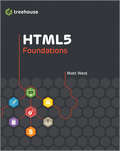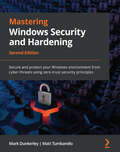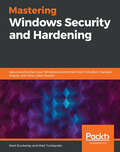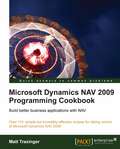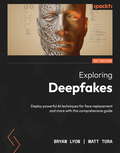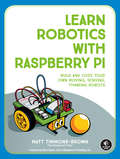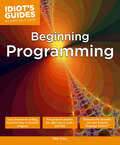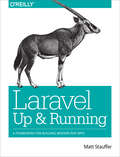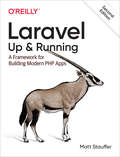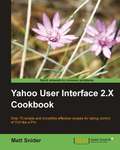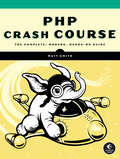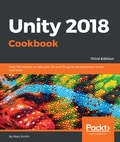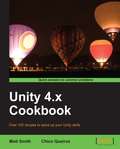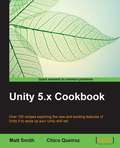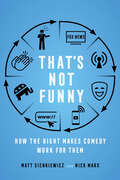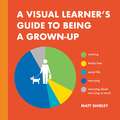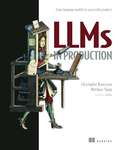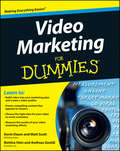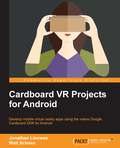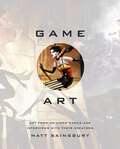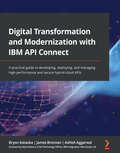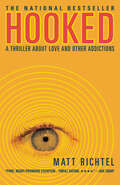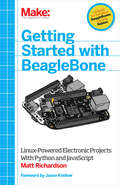- Table View
- List View
HTML5 Foundations
by Matt WestMaster innovative and eye-catching website design with the exciting new Treehouse Series of booksTurn plain words and images into stunning websites using HTML5 and this beautiful, full-colour guide. Taking you beyond the constraints of prebuilt themes and simple site building tools, this new Treehouse book combines practicality with inspiration to show you how to create fully customized, modern, and dazzling websites that make viewers want to stop and stay.The exciting new Treehouse Series of books is authored by Treehouse experts and packed with innovative design ideas and practical skill-building. If you're a web developer, web designer, hobbyist, or career-changer, every book in this practical new series should be on your bookshelf.Part of the new Treehouse Series of books, teaching you effective and compelling website development and design, helping you build practical skillsProvides career-worthy information from Treehouse industry pros and trainersExplains HTML5 basics, such as how to format text, add scripts to pages, and use HTML5 for audio and videoAlso covers hypermedia, CSS and JavaScript, embedding video, geolocation, and much moreLeverage pages of dazzling website design ideas and expert instruction with a new Treehouse Series book.
Mastering Windows Security and Hardening: Secure and protect your Windows environment from cyber threats using zero-trust security principles, 2nd Edition
by Mark Dunkerley Matt TumbarelloA comprehensive guide to administering and protecting the latest Windows 11 and Windows server operating system from ongoing cyber threats using zero-trust security principlesKey FeaturesLearn to protect your Windows environment using zero-trust and a multi-layered security approachImplement security controls using Intune, Configuration Manager, Defender for Endpoint, and moreUnderstand how to onboard modern cyber-threat defense solutions for Windows clientsBook DescriptionAre you looking for the most current and effective ways to protect Windows-based systems from being compromised by intruders? This updated second edition is a detailed guide that helps you gain the expertise to implement efficient security measures and create robust defense solutions using modern technologies. The first part of the book covers security fundamentals with details around building and implementing baseline controls. As you advance, you'll learn how to effectively secure and harden your Windows-based systems through hardware, virtualization, networking, and identity and access management (IAM). The second section will cover administering security controls for Windows clients and servers with remote policy management using Intune, Configuration Manager, Group Policy, Defender for Endpoint, and other Microsoft 365 and Azure cloud security technologies. In the last section, you'll discover how to protect, detect, and respond with security monitoring, reporting, operations, testing, and auditing. By the end of this book, you'll have developed an understanding of the processes and tools involved in enforcing security controls and implementing zero-trust security principles to protect Windows systems.What you will learnBuild a multi-layered security approach using zero-trust conceptsExplore best practices to implement security baselines successfullyGet to grips with virtualization and networking to harden your devicesDiscover the importance of identity and access managementExplore Windows device administration and remote managementBecome an expert in hardening your Windows infrastructureAudit, assess, and test to ensure controls are successfully applied and enforcedMonitor and report activities to stay on top of vulnerabilitiesWho this book is forIf you're a cybersecurity or technology professional, solutions architect, systems engineer, systems administrator, or anyone interested in learning how to secure the latest Windows-based systems, this book is for you. A basic understanding of Windows security concepts, Intune, Configuration Manager, Windows PowerShell, and Microsoft Azure will help you get the best out of this book.
Mastering Windows Security and Hardening: Secure and protect your Windows environment from intruders, malware attacks, and other cyber threats
by Mark Dunkerley Matt TumbarelloEnhance Windows security and protect your systems and servers from various cyber attacksKey FeaturesProtect your device using a zero-trust approach and advanced security techniquesImplement efficient security measures using Microsoft Intune, Configuration Manager, and Azure solutionsUnderstand how to create cyber-threat defense solutions effectivelyBook DescriptionAre you looking for effective ways to protect Windows-based systems from being compromised by unauthorized users? Mastering Windows Security and Hardening is a detailed guide that helps you gain expertise when implementing efficient security measures and creating robust defense solutions. We will begin with an introduction to Windows security fundamentals, baselining, and the importance of building a baseline for an organization. As you advance, you will learn how to effectively secure and harden your Windows-based system, protect identities, and even manage access. In the concluding chapters, the book will take you through testing, monitoring, and security operations. In addition to this, you'll be equipped with the tools you need to ensure compliance and continuous monitoring through security operations. By the end of this book, you'll have developed a full understanding of the processes and tools involved in securing and hardening your Windows environment.What you will learnUnderstand baselining and learn the best practices for building a baselineGet to grips with identity management and access management on Windows-based systemsDelve into the device administration and remote management of Windows-based systemsExplore security tips to harden your Windows server and keep clients secureAudit, assess, and test to ensure controls are successfully applied and enforcedMonitor and report activities to stay on top of vulnerabilitiesWho this book is forThis book is for system administrators, cybersecurity and technology professionals, solutions architects, or anyone interested in learning how to secure their Windows-based systems. A basic understanding of Windows security concepts, Intune, Configuration Manager, Windows PowerShell, and Microsoft Azure will help you get the best out of this book.
Microsoft Dynamics NAV 2009 Programming Cookbook
by Matt TraxingerYou won't find any fluff here. This book is written in a direct, to-the-point style to help you get what you need and continue working in NAV. At the same time it provides enough explanation so that you understand what we are doing and why it is necessary.In many programming books you will find yourself searching through paragraph after paragraph to try to find what you are looking for. That's not the case here. Each recipe starts with a short description of what it will teach. It is immediately followed with directions, usually with illustrations, of how to perform the task. You will find the explanation of the code at the end, along with some advice for further reading or other tasks you might be interested in.If you are a junior / entry-level NAV developer then the first half of the book is designed primarily for you. You may or may not have any experience programming. It focuses on the basics of NAV programming. It would be best if you have gone through a brief introduction to the NAV client.If you are a mid-level NAV developer, you will find the second half more useful. These chapters explain how to think outside of the NAV box when building solutions.There are also recipes here and there that senior developers will find useful.
Exploring Deepfakes: Deploy powerful AI techniques for face replacement and more with this comprehensive guide
by Bryan Lyon Matt ToraMaster the innovative world of deepfakes and generative AI for face replacement with this full-color guidePurchase of the print or Kindle book includes a free PDF eBookKey FeaturesUnderstand what deepfakes are, their history, and how to use the technology ethicallyGet well-versed with the workflow and processes involved to create your own deepfakesLearn how to apply the lessons and techniques of deepfakes to your own problemsBook DescriptionApplying Deepfakes will allow you to tackle a wide range of scenarios creatively.Learning from experienced authors will help you to intuitively understand what is going on inside the model. You'll learn what deepfakes are and what makes them different from other machine learning techniques, and understand the entire process from beginning to end, from finding faces to preparing them, training the model, and performing the final swap.We'll discuss various uses for face replacement before we begin building our own pipeline. Spending some extra time thinking about how you collect your input data can make a huge difference to the quality of the final video. We look at the importance of this data and guide you with simple concepts to understand what your data needs to really be successful.No discussion of deepfakes can avoid discussing the controversial, unethical uses for which the technology initially became known. We'll go over some potential issues, and talk about the value that deepfakes can bring to a variety of educational and artistic use cases, from video game avatars to filmmaking.By the end of the book, you'll understand what deepfakes are, how they work at a fundamental level, and how to apply those techniques to your own needs.What you will learnGain a clear understanding of deepfakes and their creationUnderstand the risks of deepfakes and how to mitigate themCollect efficient data to create successful deepfakesGet familiar with the deepfakes workflow and its stepsExplore the application of deepfakes methods to your own generative needsImprove results by augmenting data and avoiding overtrainingExamine the future of deepfakes and other generative AIsUse generative AIs to increase video content resolutionWho this book is forThis book is for AI developers, data scientists, and anyone looking to learn more about deepfakes or techniques and technologies from Deepfakes to help them generate new image data. Working knowledge of Python programming language and basic familiarity with OpenCV, Pillow, Pytorch, or Tensorflow is recommended to get the most out of the book.
Learn Robotics with Raspberry Pi: Build and Code Your Own Moving, Sensing, Thinking Robots
by Matt Timmons-BrownIn Learn Robotics with Raspberry Pi, you'll learn how to build and code your own robot projects with just the Raspberry Pi microcomputer and a few easy-to-get components - no prior experience necessary!Learn Robotics with Raspberry Pi will take you from inexperienced maker to robot builder. You'll start off building a two-wheeled robot powered by a Raspberry Pi minicomputer and then program it using Python, the world's most popular programming language. Gradually, you'll improve your robot by adding increasingly advanced functionality until it can follow lines, avoid obstacles, and even recognize objects of a certain size and color using computer vision. Learn how to:- Control your robot remotely using only a Wii remote- Teach your robot to use sensors to avoid obstacles- Program your robot to follow a line autonomously - Customize your robot with LEDs and speakers to make it light up and play sounds- See what your robot sees with a Pi CameraAs you work through the book, you'll learn fundamental electronics skills like how to wire up parts, use resistors and regulators, and determine how much power your robot needs. By the end, you'll have learned the basics of coding in Python and know enough about working with hardware like LEDs, motors, and sensors to expand your creations beyond simple robots.
Beginning Programming: Easy Lessons on Coding, from First Line to Finished Program (Idiot's Guides)
by Matt TellesIdiot's Guides: Beginning Programming takes the fear out of learning programming by teaching readers the basics with Python, an open-source (free) environment which is considered one of the easiest languages to learn. Readers will learn not only the "how" of programming in Python, but the "why," so they understand how the code really works and how it relates to other programming languages. Included are simple coding projects that reinforce lessons.
Laravel: A Framework for Building Modern PHP Apps
by Matt StaufferWhat sets Laravel apart from other PHP web frameworks? Speed and simplicity, for starters. This rapid application development framework and its vast ecosystem of tools let you quickly build new sites and applications with clean, readable code. With this practical guide, Matt Stauffer--a leading teacher and developer in the Laravel community--provides the definitive introduction to one of today's most popular web frameworks.The book's high-level overview and concrete examples will help experienced PHP web developers get started with Laravel right away. By the time you reach the last page, you should feel comfortable writing an entire application in Laravel from scratch.Dive into several features of this framework, including:Blade, Laravel's powerful, custom templating toolTools for gathering, validating, normalizing, and filtering user-provided dataLaravel's Eloquent ORM for working with the application's databasesThe Illuminate request object, and its role in the application lifecyclePHPUnit, Mockery, and PHPSpec for testing your PHP codeLaravel's tools for writing JSON and RESTful APIsInterfaces for file system access, sessions, cookies, caches, and searchTools for implementing queues, jobs, events, and WebSocket event publishingLaravel's specialty packages: Scout, Passport, Cashier, Echo, Elixir, Valet, and Socialite
Laravel: A Framework for Building Modern PHP Apps
by Matt StaufferWhat sets Laravel apart from other PHP web frameworks? Speed and simplicity, for starters. This rapid application development framework and its vast ecosystem of tools let you quickly build new sites and applications with clean, readable code. Fully updated to cover Laravel 5.8, the latest release, the second edition of this practical guide provides the definitive introduction to one of today’s most popular web frameworks.Matt Stauffer—a leading teacher and developer in the Laravel community—delivers a high-level overview and concrete examples to help experienced PHP web developers get started with Laravel right away. By the time you reach the last page, you should feel comfortable writing an entire application in Laravel from scratch.
Laravel: Up & Running
by Matt StaufferWhat sets Laravel apart from other PHP web frameworks? Speed and simplicity, for starters. This rapid application development framework and its ecosystem of tools let you quickly build new sites and applications with clean, readable code. Fully updated to include Laravel 10, the third edition of this practical guide provides the definitive introduction to one of today's most popular web frameworks.Matt Stauffer, a leading teacher and developer in the Laravel community, delivers a high-level overview and concrete examples to help experienced PHP web developers get started with this framework right away. This updated edition covers the entirely new auth and frontend tooling and other first-party tools introduced since the second edition.Dive into features, including:Blade, Laravel's powerful custom templating toolTools for gathering, validating, normalizing, and filtering user-provided dataThe Eloquent ORM for working with application databasesThe Illuminate request object and its role in the application lifecyclePHPUnit, Mockery, and Dusk for testing your PHP codeTools for writing JSON and RESTful APIsInterfaces for filesystem access, sessions, cookies, caches, and searchTools for implementing queues, jobs, events, and WebSocket event publishingSpecialty packages including Scout, Passport, Cashier, and more
Yahoo! User Interface Library 2.x Cookbook
by Matt SniderThis book contains recipes that showcase the common components of YUI, providing suggested examples of use, and a detailed explanation. Except for the first three chapters, which cover the 3 components of YUI that form the foundation for all other components, this book is not meant to be read cover-to-cover. Each recipe is presented as a separate, standalone entity and reading of other prior recipes is not required. Each chapter tackles a particular component or set of related components, introducing the component and explaining how to use it.If you are a web application developer and have some prior experience with or interest in using YUI 2.x to improve the UI of their web applications, then this book is for you. It assumes the reader has prior knowledge of JavaScript, HTML, CSS, and basic understanding of how a website works. This book provides an easy-to-use guide for implementing YUI 2.x components, and does not require an expertise in either JavaScript or YUI.
PHP Crash Course: The Complete, Modern, Hands-On Guide
by Matt SmithFrom First Script to Full Website—Fast!Tired of cobbling together PHP solutions from scattered online tutorials? Frustrated by outdated PHP practices that leave your code vulnerable and hard to maintain? Whether you&’re building your first dynamic website or modernizing legacy systems, PHP Crash Course gives you a complete, practical foundation for writing professional web applications.In this comprehensive, example-driven guide, you&’ll learn how to:Write clean, maintainable PHP code using modern language features and best practicesBuild secure web applications that protect against common vulnerabilitiesMaster database integration using PDO and object-relational mappings (ORMs)Implement professional features like shopping carts and user authenticationStructure applications using object-oriented programming and model-view-controller (MVC) patternsLeverage powerful tools like Composer and Twig to accelerate development Starting with PHP fundamentals, you&’ll progress through six carefully crafted sections covering essential patterns, security best practices, database integration, and advanced concepts like object-oriented programming. Each chapter builds on real-world examples, giving you the skills to solve common development challenges.Whether you&’re a complete beginner or an experienced developer looking to modernize your PHP skills, PHP Crash Course gives you everything you need to build professional, dynamic websites with confidence.Includes setup instructions for Windows, macOS, and Linux, and configuration details for Replit, the free online development environment.
Unity 2018 Cookbook: Over 160 recipes to take your 2D and 3D game development to the next level, 3rd Edition
by Matt SmithDevelop quality game components and solve common gameplay problems with various game design patternsKey FeaturesBecome proficient at traditional 2D and 3D game developmentBuild amazing interactive interfaces with Unity's UI systemDevelop professional games with realistic animation and graphics, materials and cameras, and AI with Unity 2018Book DescriptionWith the help of the Unity 2018 Cookbook, you’ll discover how to make the most of the UI system and understand how to animate both 2D and 3D characters and game scene objects using Unity's Mecanim animation toolsets.Once you’ve got to grips with the basics, you will familiarize yourself with shaders and Shader Graphs, followed by understanding the animation features to enhance your skills in building fantastic games. In addition to this, you will discover AI and navigation techniques for nonplayer character control and later explore Unity 2018’s newly added features to improve your 2D and 3D game development skills. This book provides many Unity C# gameplay scripting techniques.By the end of this book, you'll have gained comprehensive knowledge in game development with Unity 2018.What you will learnGet creative with Unity’s shaders and learn to build your own shaders with the new Shader Graph toolCreate a text and image character dialog with the free Fungus Unity pluginExplore new features integrated into Unity 2018, including TextMesh Pro and ProBuilderMaster Unity audio, including ducking, reverbing, and matching pitch to animation speedsWork with the new Cinemachine and timeline to intelligently control camera movementsImprove ambiance through the use of lights and effects, including reflection and light probesCreate stylish user interfaces with the UI system, including power bars and clock displaysWho this book is forUnity 2018 Cookbook is for you if you want to explore a wide range of Unity scripting and multimedia features and find ready-to-use solutions for many game features. This book also helps programmers explore multimedia features. It is assumed that you already know basics of Unity and have some programming knowledge of C#.
Unity 4.x Cookbook
by Chico Queiroz Matt SmithCookbook. From beginners to advanced users, from artists to coders, this book is for you and everyone in your team! This book is for anyone who wants to explore a wide range of Unity scripting and multimedia features and to find ready to use solutions to many game features. Programmers can explore multimedia features, and multimedia developers can try their hand at scripting.
Unity 4.x Cookbook
by Chico Queiroz Matt SmithCookbook. From beginners to advanced users, from artists to coders, this book is for you and everyone in your team! This book is for anyone who wants to explore a wide range of Unity scripting and multimedia features and to find ready to use solutions to many game features. Programmers can explore multimedia features, and multimedia developers can try their hand at scripting.
That's Not Funny: How the Right Makes Comedy Work for Them
by Matt SienkiewiczA rousing call for liberals and progressives to pay attention to the emergence of right-wing comedy and the political power of humor. "Why do conservatives hate comedy? Why is there no right-wing Jon Stewart?" These sorts of questions launch a million tweets, a thousand op-eds, and more than a few scholarly analyses. That's Not Funny argues that it is both an intellectual and politically strategic mistake to assume that comedy has a liberal bias. Matt Sienkiewicz and Nick Marx take readers––particularly self-described liberals––on a tour of contemporary conservative comedy and the "right-wing comedy complex." In That's Not Funny, "complex" takes on an important double meaning. On the one hand, liberals have developed a social-psychological complex—it feels difficult, even dangerous, to acknowledge that their political opposition can produce comedy. At the same time, the right has been slowly building up a comedy-industrial complex, utilizing the humorous, irony-laden media strategies of liberals such as Jon Stewart, Samantha Bee, and John Oliver to garner audiences and supporters. Right-wing comedy has been hiding in plain sight, finding its way into mainstream conservative media through figures ranging from Fox News's Greg Gutfeld to libertarian podcasters like Joe Rogan. That's Not Funny taps interviews with conservative comedians and observations of them in action to guide readers through media history, text, and technique. You will find many of these comedians utterly appalling, some surprisingly funny, and others just plain weird. They are all, however, culturally and politically relevant—the American right is attempting to seize spaces of comedy and irony previously held firmly by the left. You might not like this brand of humor, but you can't ignore it.
A Visual Learner's Guide to Being a Grown-Up
by Matt ShirleyBased on Matt Shirley's popular Instagram account, this smart and hilarious guide is a collection of tables, lists, and charts for all the visual learners out there striving to be a successful grown-up.We all know the particular pain that comes with having to be an actual adult, whether it's resetting your internet password on ten different sites, yearning for an excuse to get out of the plans your wife made for you months ago, or the anxiety that comes from forcing yourself to work out again.When Matt Shirley became fed up with being a grown-up, he started drawing charts as a more fun and efficient way to cope with his frustrations, and stuck them up on Instagram where they became an instant hit. Packed with over one hundred charts, graphs, diagrams, and infographics—with 50 percent brand-new material—this hilarious collection vows to explain everything you need to know about how to be a grown-up, covering work, family, and friends, to dating, breakups, and more.From explaining the cycle of adulthood to decoding the pros and cons of first dates to understanding the corporate lingo translator, Shirley's charts cut to the core of how to be an adult in the funniest possible way.
LLMs in Production: Engineering AI Applications
by Christopher Brousseau Matt SharpGoes beyond academic discussions deeply into the applications layer of Foundation Models.This practical book offers clear, example-rich explanations of how LLMs work, how you can interact with them, and how to integrate LLMs into your own applications. Find out what makes LLMs so different from traditional software and ML, discover best practices for working with them out of the lab, and dodge common pitfalls with experienced advice. In LLMs in Production you will: • Grasp the fundamentals of LLMs and the technology behind them • Evaluate when to use a premade LLM and when to build your own • Efficiently scale up an ML platform to handle the needs of LLMs • Train LLM foundation models and finetune an existing LLM • Deploy LLMs to the cloud and edge devices using complex architectures like PEFT and LoRA • Build applications leveraging the strengths of LLMs while mitigating their weaknesses LLMs in Production delivers vital insights into delivering MLOps so you can easily and seamlessly guide one to production usage. Inside, you&’ll find practical insights into everything from acquiring an LLM-suitable training dataset, building a platform, and compensating for their immense size. Plus, tips and tricks for prompt engineering, retraining and load testing, handling costs, and ensuring security. Foreword by Joe Reis. About the technology Most business software is developed and improved iteratively, and can change significantly even after deployment. By contrast, because LLMs are expensive to create and difficult to modify, they require meticulous upfront planning, exacting data standards, and carefully-executed technical implementation. Integrating LLMs into production products impacts every aspect of your operations plan, including the application lifecycle, data pipeline, compute cost, security, and more. Get it wrong, and you may have a costly failure on your hands. About the book LLMs in Production teaches you how to develop an LLMOps plan that can take an AI app smoothly from design to delivery. You&’ll learn techniques for preparing an LLM dataset, cost-efficient training hacks like LORA and RLHF, and industry benchmarks for model evaluation. Along the way, you&’ll put your new skills to use in three exciting example projects: creating and training a custom LLM, building a VSCode AI coding extension, and deploying a small model to a Raspberry Pi. What's inside • Balancing cost and performance • Retraining and load testing • Optimizing models for commodity hardware • Deploying on a Kubernetes cluster About the reader For data scientists and ML engineers who know Python and the basics of cloud deployment. About the author Christopher Brousseau and Matt Sharp are experienced engineers who have led numerous successful large scale LLM deployments. Table of Contents 1 Generative AI: Why large language models have captured attention 2 Large language models: A deep dive into language modeling 3 Large language model operations: Building a platform for LLMs 4 Data engineering for large language models: Setting up for success 5 Training large language models: How to generate the generator 6 Large language model services: A practical guide 7 Prompt engineering: Becoming an LLM whisperer 8 Applications and Agents: Building an interactive experience 9 Creating an LLM project: Reimplementing Llama 3 10 Creating a coding copilot project: This would have helped you earlier 11 Deploying an LLM on a Raspberry Pi: How low can you go? 12 Creating a coding copilot project: Integrating an LLM service into VS Code with RAG started A History of linguistics B Reinforcement learning with human feedback C Multimodal latent spaces
Video Marketing For Dummies
by Kevin Daum Andreas Goeldi Matt Scott Bettina HeinSavvy advice for adding video to your marketing planVideo marketing is rapidly gaining popularity in online marketing and this fun-but-practical guide presents you with all aspects of video marketing from planning to production to distribution. You'll learn how to create a video strategy, produce an effective video, put it online, and get your video to the right consumers so you can help your business succeed. The author team has vast experience in video creation and marketing and explores ten video campaigns so you can learn from their successes and challenges.Offers an overview of the video marketing process, how to build it into an existing marketing plan, and create a video outlineCovers the necessary steps for creating the video, from scripting to shooting to editingWalks you through the process of sharing video on a company site, social site, or other hosts and then draw the right audienceDetails the new frontiers of video marketing including mobile video and measuring resultsFeaturing invaluable advice for creating an effective video marketing campaign, Video Marketing For Dummies is essential reading on this marketing trend.
Cardboard VR Projects for Android
by Jonathan Linowes Matt SchoenDevelop mobile virtual reality apps using the native Google Cardboard SDK for Android About This Book * Learn how to build practical applications for Google's popular DIY VR headset * Build a reusable VR graphics engine on top of the Cardboard Java SDK and OpenGL ES graphics libraries * The projects in this book will showcase a different aspect of Cardboard development--from 3D rendering to handling user input Who This Book Is For The book is for established Android developers with a good knowledge level of Java. No prior OpenGL or graphics knowledge is required. No prior experience with Google Cardboard is expected, but those who are familiar with Cardboard and are looking for projects to expand their knowledge can also benefit from this book. What You Will Learn * Build Google Cardboard virtual reality applications * Explore the ins and outs of the Cardboard SDK Java classes and interfaces, and apply them to practical VR projects * Employ Android Studio, Android SDK, and the Java language in a straightforward manner * Discover and use software development and Android best practices for mobile and Cardboard applications, including considerations for memory management and battery life * Implement user interface techniques for menus and gaze-based selection within VR * Utilize the science, psychology, mathematics, and technology behind virtual reality, especially those pertinent to mobile Cardboard VR experiences * Understand Cardboard VR best practices including those promoted by Google Design Lab. In Detail Google Cardboard is a low-cost, entry-level media platform through which you can experience virtual reality and virtual 3D environments. Its applications are as broad and varied as mobile smartphone applications themselves. This book will educate you on the best practices and methodology needed to build effective, stable, and performant mobile VR applications. In this book, we begin by defining virtual reality (VR) and how Google Cardboard fits into the larger VR and Android ecosystem. We introduce the underlying scientific and technical principles behind VR, including geometry, optics, rendering, and mobile software architecture. We start with a simple example app that ensures your environment is properly set up to write, build, and run the app. Then we develop a reusable VR graphics engine that you can build upon. And from then on, each chapter is a self-contained project where you will build an example from a different genre of application, including a 360 degree photo viewer, an educational simulation of our solar system, a 3D model viewer, and a music visualizer. Style and approach This project based guide is written in a tutorial-style project format, where you will learn by doing. It is accompanied by in-depth explanations and discussions of various technologies, and provides best practices and techniques.
Game Art: Art from 40 Video Games and Interviews with Their Creators
by Matt SainsburyGame Art is a collection of breathtaking concept art and behind-the-scenes interviews from videogame developers, including major players like Square Enix, Bioware, and Ubisoft as well as independent but influential studios like Tale of Tales and Compulsion Games. Immerse yourself in fantastic artwork and explore the creative thinking behind over 40 console, mobile, and PC games.A lone independent developer on a tiny budget can create an experience as powerful and compelling as a triple-A blockbuster built by a team of 1,000. But like all works of art, every game begins with a spark of inspiration and a passion to create.Let Game Art take you on a visual journey through these beautiful worlds, as told by the minds that brought them to life.
Digital Transformation and Modernization with IBM API Connect: A practical guide to developing, deploying, and managing high-performance and secure hybrid-cloud APIs
by Matt Roberts James Brennan Bryon Kataoka Ashish AggarwalSuccessfully execute a strategic roadmap of digital transformation and modernize your enterprise with a proven API-led agile implementation approach by unlocking the full range of features in IBM API Connect Version 10Key FeaturesExplore techniques to design and deliver valuable customer-centric APIs using API ConnectManage your APIs with improved security and optimal performance across many channelsUncover hidden capabilities that help improve business agility and management within your API ecosystemBook DescriptionIBM API Connect enables organizations to drive digital innovation using its scalable and robust API management capabilities across multi-cloud and hybrid environments. With API Connect's security, flexibility, and high performance, you'll be able to meet the needs of your enterprise and clients by extending your API footprint. This book provides a complete roadmap to create, manage, govern, and publish your APIs. You'll start by learning about API Connect components, such as API managers, developer portals, gateways, and analytics subsystems, as well as the management capabilities provided by CLI commands. You'll then develop APIs using OpenAPI and discover how you can enhance them with logic policies. The book shows you how to modernize SOAP and FHIR REST services as secure APIs with authentication, OAuth2/OpenID, and JWT, and demonstrates how API Connect provides safeguards for GraphQL APIs as well as published APIs that are easy to discover and well documented. As you advance, the book guides you in generating unit tests that supplement DevOps pipelines using Git and Jenkins for improved agility, and concludes with best practices for implementing API governance and customizing API Connect components. By the end of this book, you'll have learned how to transform your business by speeding up the time-to-market of your products and increase the ROI for your enterprise.What you will learnUse API Connect to create, manage, and publish customer-centric, API-led solutionsRun CLI commands to manage API configuration and deploymentsCreate REST, SOAP, and GraphQL APIs securely using OpenAPISupport OAuth and JWT security methods using policiesCreate custom policies to supplement securityApply built-in policies to transform payloadsUse CLIs and unit testing hooks within DevOps pipelinesFind out how to customize Analytics dashboards and Portal User InterfaceWho this book is forThis book is for developers and architects who want to achieve digital transformation using IBM API Connect and successfully execute the strategic roadmap of enterprise modernization while effectively managing their API ecosystem. A solid understanding of what RESTful services and APIs can do and where to implement API security is necessary to get started. Experience in application development and basic knowledge of microservices, container orchestration, and cloud environments will help you to get the most out of this book.
Hooked: A Thriller About Love and Other Addictions
by Matt RichtelNat Idle, a San Francisco writer with a medical degree, narrowly survives an explosion in an Internet cafe after a stranger hands him a note warning him to exit immediately. The handwriting on the note belongs to his deceased girlfriend, a Silicon Valley venture capitalist whom he has obsessively been mourning. So begins HOOKED, a pop thriller for the Internet Age, written with the force of an adrenaline rush and the pace of an intimate email dispatch you can't stop reading. Each chapter of this novel will keep readers hooked as Nat Idle searches for the love of his life in the midst of manipulation and conspiracy.
Getting Started with BeagleBone: Linux-Powered Electronic Projects With Python and JavaScript
by Matt RichardsonMany people think of Linux as a computer operating system, running on users' desktops and powering servers. But Linux can also be found inside many consumer electronics devices. Whether they're the brains of a cell phone, cable box, or exercise bike, embedded Linux systems blur the distinction between computer and device. Many makers love microcontroller platforms such as Arduino, but as the complexity increases in their projects, they need more power for applications, such as computer vision. The BeagleBone is an embedded Linux board for makers. It's got built-in networking, many inputs and outputs, and a fast processor to handle demanding tasks. This book introduces you to both the original BeagleBone and the new BeagleBone Black and gets you started with projects that take advantage of the board's processing power and its ability to interface with the outside world.
